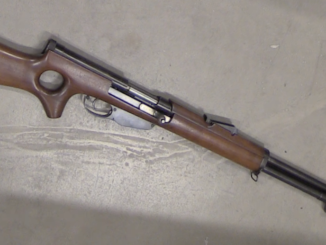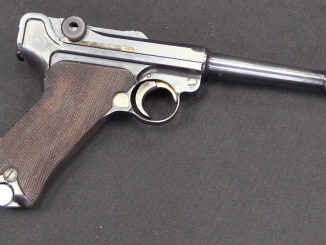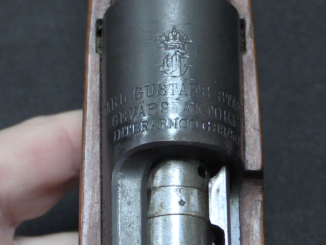I have been thinking about machine gun optics for a while, as I am on the waiting list for a Lage Max 11/15A1 5.56mm upper for my M11A1 (registered and legal) machine pistol. I am fitting the Lage upper with a BlkLbl bipod/handguard, and that leaves the question of what sighting system to put on it. Red dots allow one to maintain a sight picture while firing, but offer no ability to identify targets beyond range of the naked eye. Magnified optics allow much better visibility, but are difficult to use effectively beyond the first shot in a burst. Even a variable at 1x has an eye box and relatively fine reticle.
The solution I have found that I think will be the best compromise is the Spuhr BAM (Ballistic Adjustable Mount). This is a mounting platform that holds an Aimpoint CompM4 red dot and an Aimpoint 3x magnifier and has a BDC allowing both dot and magnifier to be adjusted to hit at 250, 400, 500, or 600m. The Aimpoint has no holdovers in its reticle (which is just a plain dot), so this adjustment allows the dot to be used effectively out to the maximum effective range of the 5.56mm cartridge. The magnifier is fitted via a flip-over/twist-off mount, so it can be flipped out of the way when not in use (ie, after a target is identified), or detached completely when not wanted.
I am really eager to get this mounted on the Lage Max 11/15A1 and actually try it out on the range! This rig is not exactly cheap, and I am grateful to Spuhr for providing me with the BAM mount, and to Optics Planet for providing the Aimpoint and magnifier. Everything Spuhr makes is of excellent quality, and I highly recommend him for all sorts of scope mounts, if you can afford his work.




Hi,
That’s quite a project, and an interesting theory of LMG shooting. I look forward to the results of your experimentation.
Your detailed descriptions of the French Mdle 24/29, the German MG13, and your participation in Project Lightening I found very illuminating of the era of LMG use and development. Thanks to that I now have a theory of how the French and Germans intended to shoot those unusual post WWI LMG and the reasons why.
My own very limited personal experience firing a LMG was eye opening. When I pulled the trigger on the BAR Type D, my sight picture was gone and even my view of the target was impaired as my head was bounced around during the recoil of the bursts. So color me skeptical of maintaining a sight picture during a LMG burst while using a standard cheek weld, regardless of the type of sight.
My current theory is keeping ones head out of contact with the LMG while using a red dot sight, might work to maintain a sight picture during the burst.
In case of interest, here is my theory about the 7.5mm Mdle 24/29 and 7.9mm MG13.
Despite the many differences, those French and German LMG share a interesting number of similarities of unusual features. So I can’t help but think those features were derived from extensive combat experience with MG during WWI.
I theorize the semi-auto triggers were intended not for pure semi-auto-fire uses, but instead as a means of improving the full auto fire function during combat.
Those 25 round magazine fed LMG, obviously have a very limited duration of full-auto fire before the magazine would need changing. A partial magazine when engaging a new target might be completely wasted, as the gunner empties the magazine as he walks his first burst of fire onto the new target. Requiring a magazine change, and another ranging burst to walk rounds onto the target.
So my theory is that an appropriate target, would first be shot at using the semi-auto trigger to range the target, and then switch to the full auto trigger to fire the bursts. In fact, I suspect the doctrine was to fire an entire magazine at a target, rather than continue with a partial magazine. Somewhat similar to how M1 rifleman of WW2 would fire off an entire clip of ammunition if opening fire.
This practice of firing an entire magazine per target, might be enhanced by loading the magazine so that the first 3-5 cartridges fed are tracer, to enhance ranging the target. The rest of the cartridges might be the usual ball.
I’ve experimented very briefly w/ a similar setup on the Army’s 300m pop-up range w/ an issue M4A1, M855A1, & an Aimpoint M4. I tried out Lucid’s 2-5X variable on a very cheap flip-off mount, which gave my post-retirement age Mark 1s an easy zero at 5X. On the pop-up range, however, while I could actually see and hit the 300m targets, getting down into the eyebox for the 50m targets was very time consuming, and being no great shot, failed to qualify. Popped the magnifier off, no trouble the next go round. No doubt if I’d practiced flipping the magnifier on and off I’d’ve done much better.
It would be really interesting to see Ian shoot the Army rifle qual course w/ his machinegun, flipping his very nice magnifier back & forth.
Surely I can’t be the only one, who’ll be severely disappointed, if this new sight doesn’t end up on a Chauchat, and gets a day on the range?!
Come on Ian, you know you want to!
During WW2 both the Japanese and Germans had optics for their light machineguns. For the Japanese the Type 96 and 99 LMG and the Germans the MG 42.
MG 34 and 42 use the same tripod with scope mount on the tripod. The post-war derivatives of the MG 42 also have various tripods developed for them with scope mounts. These scopes are normally quite low magnification bur have a bullet drop compensating reticule to make targeting much easier.
The optics would mainly be for aiming the gun for the first couple of shots though. If you’re shooting 600-1000 rpm, precision isn’t that important. Random chance of some of those hundreds of bullets hitting the target is your friend.
And of course, for both the Germans and the Japanese, suppressive fire was one of the MGs primary roles.
It doesn’t matter if every 400 m shot is on target or not. The important part is that it makes the enemy keeps their heads down, so you can send some riflemen to flank them.
Well, the Japanese did resort to using their light machine guns as primary killing power. The Germans did the same, firing to saturate and slaughter, not to scare and suppress. Why? The Wehrmacht was rather short on well-trained riflemen when it invaded Poland. To compensate for this and the lack of available field artillery, infantry fighting doctrine for the Germans began to bunch the platoon around a readily mobile machine gun, with the riflemen supporting the machine gunners. When the Pacific theater turned sour for the Imperial Japanese Army, their infantry began doing similar practices when planning for defensive operations. I mean, Iwo Jima was hardly a case of sending out the riflemen just to get run over by American tanks. Instead, the infantry bunched around the machine guns in camouflaged bunkers and used the machine guns to saturate predetermined kill-zones, not to terrify American Marines into pissing their pants. But, as it were, I could be wrong.
Not quite. The Germans used the MG42 on mounts to fire precice bursts on single targets. Not every shot hit, but this is still some type of precision work, and in effect quite comparable to what you do with a DMR (only with more shots and less precision)
Looks like someone got too many played in CounterStrike. 😉
LMG doesn’t work like that.
This is not a garden watering can.
A machine gun is just a long range shotgun, you point it “That-a-way” and fire.
Heh, that “innovative patent pending bipod”…reinventing the wheel a bit there. The FAMAS has the same idea, and variants of both the G3 and FAL (Austrian Stg. 58, off the top of my head) both came with integrated bipods in the handguard.